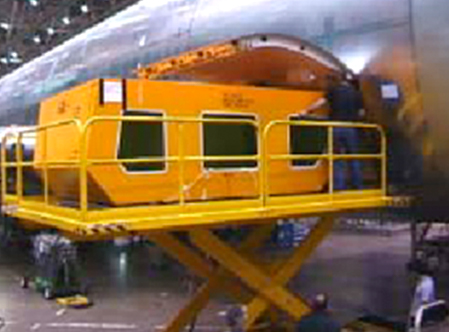Aircraft Fuel Tank Positioning Lift

Introduction
High Travel, High Capacity Scissor lift installed to move large auxiliary fuel tank.
Project Challenge
A major aircraft manufacturer was developing a means to extend the available flight times of existing aircraft by retrofitting auxiliary fuel tanks into the fuselage. There could be no modifications to the structural frame of the plane, so a means to install this auxiliary tank through existing doors had to be developed.
Specific design requirements of a material lift to accomplish this task were:
1) must operate using available shop air supply.
2) must be portable/towable.
3) must have ball transfers on top of the lift deck to more precisely position the tank into the aircraft.
Our Solution
An Autoquip design team met with aerospace engineers from the customer’s factory to review potential lifting solutions. Because of the portability requirement, the solution had to be based on a scissor lift design. Due to the of the nature of the load, the scissor lift needed to have an extremely large platform that would remain very level throughout the lift’s vertical travel, and stay level while the load was being transferred off the lift into the plane.
Autoquip ultimately recommended and developed a high-travel, high capacity scissor lift with a customized platform and towable transport base that could use the available shop air supply to operate an air motor/hydraulic pump combination. This solution provided the simplest and most stable lifting solution for the application. The tooling engineer is completely satisfied with a material lift that was customized to adapt to the constraints of the job site and to the limited accessibility into the aircraft. The assembly personnel are able to complete the installation of the tank safely, easily, and under budget Lift Specifications for this Unique Application:
The Results
Through the use of Autoquip’s custom designed scissor lift, the process of retro-fitting these tanks is accomplished in 20 minutes rather than the originally projected 2 hours, and the customer’s goals have been achieved with minimal disruption to the manufacturing process.